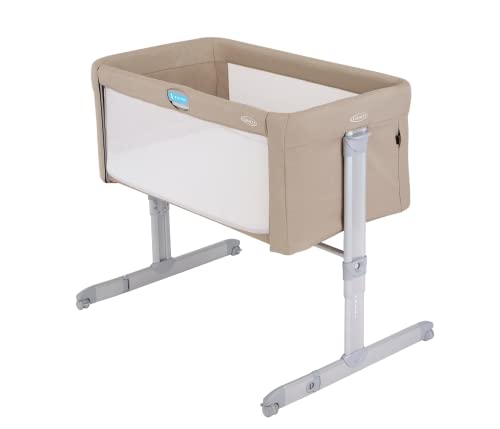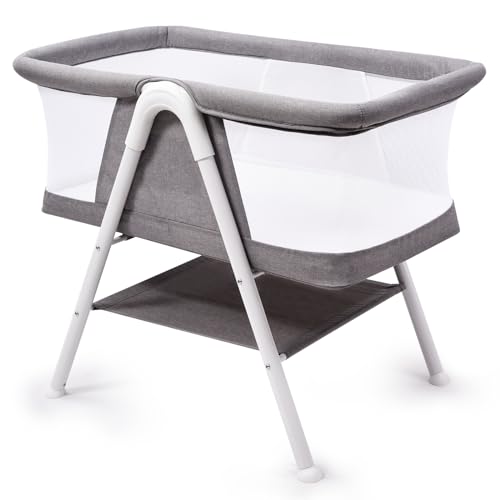You'll Never Be Able To Figure Out This Bedside Cosleeper's Tricks
페이지 정보
작성자 Doreen 댓글 0건 조회 7회 작성일 25-02-01 13:16본문
Bedside Cosleeper
 A bedside cosleeper is a bassinet which is attached to the side of your adult bed. If you stick to the CSPC guidelines for sleeping areas for infants it's secure.
A bedside cosleeper is a bassinet which is attached to the side of your adult bed. If you stick to the CSPC guidelines for sleeping areas for infants it's secure.
 These guidelines are very similar to crib bedding standards. You can read more about these guidelines here. The most important factors to consider when selecting the best bedside cots for newborns sleeper are Safety Comfort, Convenience, and Safety.
These guidelines are very similar to crib bedding standards. You can read more about these guidelines here. The most important factors to consider when selecting the best bedside cots for newborns sleeper are Safety Comfort, Convenience, and Safety.
Safety
Many new parents and pregnant mothers have chosen to cosleep which is also known as bed-sharing, in accordance with the American Academy of Pediatrics recommendation that infants should sleep in the same room as their parents. The Academy notes that room-sharing is more secure than sleeping with an infant in the same bed because it decreases the risk of Sudden Unexpected Death in Infants or SIDS. While the AAP discourages bed-sharing, it does recommend that co-sleeping be done on a separate sleep surface to limit the risk of SIDS. The creation of the bedside crib was important for a number of families.
A bedside cosleeper can be described as a crib-like sleeper that is attached to an adult bed frame. The bedside cosleeper enables parents to monitor their child and allows parents the freedom of an adult bed while keeping their baby close by. The best cosleepers have strict safety standards and are made using durable, high-quality materials. Be sure to look for the Juvenile Products Manufacturers Association (JPMA) stamp of approval, which indicates rigorous product testing and quality controls, bedside cosleeper to ensure your child's safety cosleeping experience.
The safety of a crib is contingent on a variety of factors. This includes how it's set up and secured onto the parent's mattress. It is crucial that the bedside sleeper be connected to the mattress of the parent in a way that does not create gaps and spaces, in which the infant may be trapped. This could result in an entrapment risk. It is essential that the attachment system for a bedside sleeper be tested to ensure that it is able to withstand any forces that are applied to it during use, like the parent moving on and off the sleeper. The attachment system or the corners on the bedside cosleeper should be tested against an upward force.
The standard for bedside crib co sleeper sleepers includes by reference the federal consumer safety standard for bassinets and cradles (16 CFR part 1218), which includes performance requirements for enclosed openings with a fabric-side. The mandatory requirements of the standard also address head and neck entrapment hazards by requiring that after the application and release of 50-lb. horizontal force near the attachment systems and corners of the bedside sleeper, an opening larger than 1.0 in. is not allowed to be created. ASTM's electronic Reading Room offers read-only versions of the standard.
Convenience
While many parents have avoided cosleeping due to fear of suffocation, SIDS or the "Ferberization" process that makes children to sleep alone Anthropologists have long observed that mammals and primates as well as those living in non-Western societies, frequently co-slept. This is because babies are soothed by hearing their mother's voice, and they also learn to self-soothe.
The top bedside sleepers have clever designs that are attached on the side of any mattress and swivels so you can access it easily for diaper changes or feedings in the middle of the night. Choose a model that has feet that can be adjusted to accommodate different sizes of mattresses. It should also include an ample storage area to store all of your baby's essentials.
Select a bedside baby sleeper sleeper that fits the standard crib bedding so that it can be used in a safe manner as your child grows. You might also think about an adjustable model that can transform into a play area or a more deep bassinet for a long time of use. It folds easily for transport.
Portability
A bedside cosleeper with wheels or a base that is lightweight is easier to move than one with a bulky wooden frame or a substantial base. The babybay bedside cot wooden sleeper HALO bassiNest essencetia, and Snoo Smart Sleeper are all portable. They come with feet that can be adjusted that can be retracted to accommodate platforms; legs that fold up so that they are in close proximity to the mattress; and 100 mesh sidewalls that allow ventilation without covering the baby's nose or mouth.
The Arm's Reach ClearVue is another popular option that adjusts in 1" increments to fit in most adult beds and can also be used as a portable bassinet. It also pivots to allow quick access to the baby to comfort her, nurse her, or check on them during the night.
 A bedside cosleeper is a bassinet which is attached to the side of your adult bed. If you stick to the CSPC guidelines for sleeping areas for infants it's secure.
A bedside cosleeper is a bassinet which is attached to the side of your adult bed. If you stick to the CSPC guidelines for sleeping areas for infants it's secure. These guidelines are very similar to crib bedding standards. You can read more about these guidelines here. The most important factors to consider when selecting the best bedside cots for newborns sleeper are Safety Comfort, Convenience, and Safety.
These guidelines are very similar to crib bedding standards. You can read more about these guidelines here. The most important factors to consider when selecting the best bedside cots for newborns sleeper are Safety Comfort, Convenience, and Safety.Safety
Many new parents and pregnant mothers have chosen to cosleep which is also known as bed-sharing, in accordance with the American Academy of Pediatrics recommendation that infants should sleep in the same room as their parents. The Academy notes that room-sharing is more secure than sleeping with an infant in the same bed because it decreases the risk of Sudden Unexpected Death in Infants or SIDS. While the AAP discourages bed-sharing, it does recommend that co-sleeping be done on a separate sleep surface to limit the risk of SIDS. The creation of the bedside crib was important for a number of families.
A bedside cosleeper can be described as a crib-like sleeper that is attached to an adult bed frame. The bedside cosleeper enables parents to monitor their child and allows parents the freedom of an adult bed while keeping their baby close by. The best cosleepers have strict safety standards and are made using durable, high-quality materials. Be sure to look for the Juvenile Products Manufacturers Association (JPMA) stamp of approval, which indicates rigorous product testing and quality controls, bedside cosleeper to ensure your child's safety cosleeping experience.
The safety of a crib is contingent on a variety of factors. This includes how it's set up and secured onto the parent's mattress. It is crucial that the bedside sleeper be connected to the mattress of the parent in a way that does not create gaps and spaces, in which the infant may be trapped. This could result in an entrapment risk. It is essential that the attachment system for a bedside sleeper be tested to ensure that it is able to withstand any forces that are applied to it during use, like the parent moving on and off the sleeper. The attachment system or the corners on the bedside cosleeper should be tested against an upward force.
The standard for bedside crib co sleeper sleepers includes by reference the federal consumer safety standard for bassinets and cradles (16 CFR part 1218), which includes performance requirements for enclosed openings with a fabric-side. The mandatory requirements of the standard also address head and neck entrapment hazards by requiring that after the application and release of 50-lb. horizontal force near the attachment systems and corners of the bedside sleeper, an opening larger than 1.0 in. is not allowed to be created. ASTM's electronic Reading Room offers read-only versions of the standard.
Convenience
While many parents have avoided cosleeping due to fear of suffocation, SIDS or the "Ferberization" process that makes children to sleep alone Anthropologists have long observed that mammals and primates as well as those living in non-Western societies, frequently co-slept. This is because babies are soothed by hearing their mother's voice, and they also learn to self-soothe.
The top bedside sleepers have clever designs that are attached on the side of any mattress and swivels so you can access it easily for diaper changes or feedings in the middle of the night. Choose a model that has feet that can be adjusted to accommodate different sizes of mattresses. It should also include an ample storage area to store all of your baby's essentials.
Select a bedside baby sleeper sleeper that fits the standard crib bedding so that it can be used in a safe manner as your child grows. You might also think about an adjustable model that can transform into a play area or a more deep bassinet for a long time of use. It folds easily for transport.
Portability
A bedside cosleeper with wheels or a base that is lightweight is easier to move than one with a bulky wooden frame or a substantial base. The babybay bedside cot wooden sleeper HALO bassiNest essencetia, and Snoo Smart Sleeper are all portable. They come with feet that can be adjusted that can be retracted to accommodate platforms; legs that fold up so that they are in close proximity to the mattress; and 100 mesh sidewalls that allow ventilation without covering the baby's nose or mouth.
The Arm's Reach ClearVue is another popular option that adjusts in 1" increments to fit in most adult beds and can also be used as a portable bassinet. It also pivots to allow quick access to the baby to comfort her, nurse her, or check on them during the night.
- 이전글비아그라인터넷판매 비아그라 처방 25.02.01
- 다음글The 10 Most Scariest Things About Untreated ADHD In Adults Test 25.02.01
댓글목록
등록된 댓글이 없습니다.